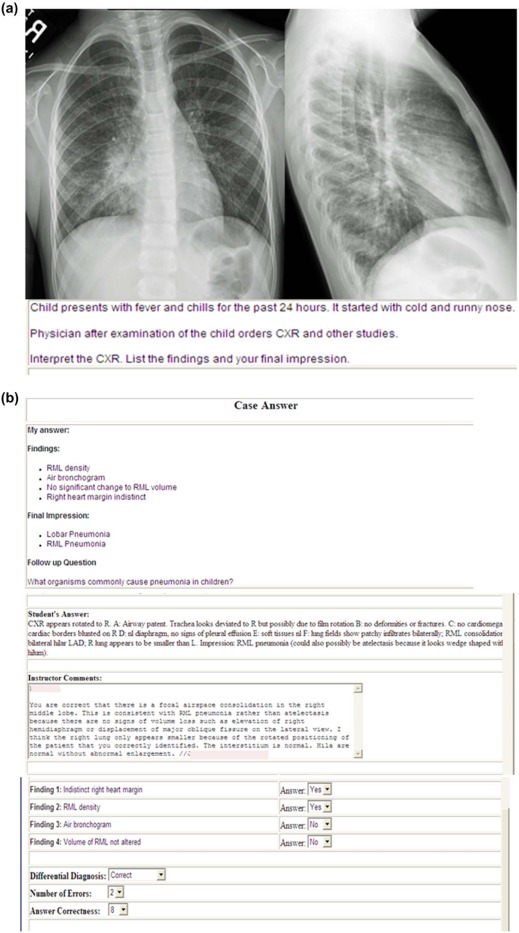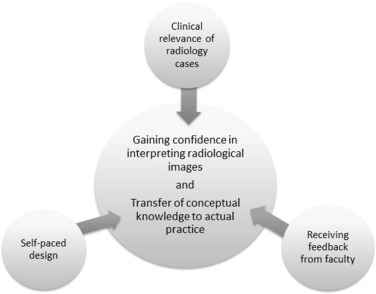Rationale and Objectives
The principles of Collins’ cognitive apprenticeship model were used to design a radiology curriculum in which medical students practice radiological skills using online case-based modules. The modules are embedded within clinical third-year clerkships, and students are provided with personalized feedback from the instructors. We describe the development of the vertical online radiology curriculum and evaluate its impact on student achievement and learning process using a mixed method approach.
Materials and Methods
The curriculum was developed over a 2-year period. Student participation was voluntary in the first year and mandatory in the second year. For quantitative curriculum evaluation, student metrics for voluntary versus mandatory groups were assessed using independent sample t tests and variable entry method regression analysis. For qualitative analysis, responses from a survey of students about the value of the curriculum were organized into defined themes using consensus coding.
Results
Mandatory participation significantly improved (p = .001) the mean radiology examination score (82 %) compared to the voluntary group (73%), suggesting that mandatory participation had a beneficial effect on student performance. Potential preexisting differences in underlying general academic performance were accounted for by including mean basic science grades as the first variable in the regression model. The significant increase in R 2 from .16 to .28 when number of radiology cases completed was added to the original model, and the greater value of the standardized beta for this variable, suggest that the curriculum made a significant contribution to students’ radiology examination scores beyond their baseline academic performance. Five dominant themes about curricular characteristics that enhanced student learning and beneficial outcomes emerged from consensus coding. These themes were (1) self-paced design, (2) receiving feedback from faculty, (3) clinical relevance of cases, (4) gaining confidence in interpreting radiological images, and (5) transfer of conceptual knowledge to actual practice.
Conclusions
The vertically integrated online radiology curriculum can positively impact student performance and learning process in the context of the cognitive apprenticeship model.
Introduction
Radiological imaging is widely acknowledged as an essential element of modern medical practice. Accordingly, increasing attention has been given to the importance of preparing medical students to become responsible users of medical imaging by including radiology in the curriculum. Methods of teaching radiology range from stand-alone clerkships composed of dedicated blocks of time, to longitudinal or vertically integrated clerkships in which content is distributed throughout the year and coordinated with other topics . The primary rationale for favoring a vertically integrated approach is that it promotes context-specific learning with relevant radiology material presented alongside corresponding clinical conditions and patient contact .
Presenting material in a vertically integrated manner fosters durable learning by making the material relevant to students’ practical, real-life clinical work . These same precepts form the foundation of Collins’ cognitive apprenticeship theory, which emphasizes purposeful practice of target skills within the functional context of their use . The cognitive apprenticeship model promotes active problem solving and transfer of conceptual knowledge from the abstract stage to the phase of successful execution of the target task in a practical, authentic framework. This model is germane to all types of cognitive learning, including clinical medical education. According to this learning framework, preexisting cognitive skills are reinforced by repeated attempts to execute the target process under the guidance of an expert practitioner. Performance of the targeted task in successive approximations of proficiency replicates the gradual growth of expertise, similar to what occurs in a traditional apprenticeship.
Get Radiology Tree app to read full this article<
Materials and Methods
Get Radiology Tree app to read full this article<
Curriculum Development
Get Radiology Tree app to read full this article<
Get Radiology Tree app to read full this article<
Case Selection
Get Radiology Tree app to read full this article<
Table 1
Number of Cases and Sample Case Topics for Radiology Curriculum, Sorted by Corresponding Clinical Clerkship
Clerkship Number of Cases Sample Case Topics Medicine 8
Surgery 8
Family Medicine 6
Pediatrics 6
OB-Gyn 6
Neurology 4
Get Radiology Tree app to read full this article<
Case Presentation
Get Radiology Tree app to read full this article<
Get Radiology Tree app to read full this article<
Faculty Feedback
Get Radiology Tree app to read full this article<
Participation
Get Radiology Tree app to read full this article<
Student Performance
Get Radiology Tree app to read full this article<
Get Radiology Tree app to read full this article<
Curriculum Evaluation
Get Radiology Tree app to read full this article<
Quantitative Analysis
Get Radiology Tree app to read full this article<
Get Radiology Tree app to read full this article<
Qualitative Analysis
Get Radiology Tree app to read full this article<
Results
Curriculum Development
Get Radiology Tree app to read full this article<
Get Radiology Tree app to read full this article<
Curriculum Evaluation
Quantitative Analysis
Get Radiology Tree app to read full this article<
Get Radiology Tree app to read full this article<
Table 2
Multiple Regression Models of Relationships of Independent Variables to Radiology Examination Score
Independent Variables in Model F R 2 Change R 2 B__t Model 1: Basic Science Examination Score 47.94 \* .16 .40 6.9 \* Model 2: Basic Science Examination Score
Number Radiology Cases Answered 47.6 \* .28 .12 \* .33
.35 6.0 \*
6.3 \*
Get Radiology Tree app to read full this article<
Get Radiology Tree app to read full this article<
Qualitative Analysis
Get Radiology Tree app to read full this article<
Table 3
Dominant Themes Found by Analysis of 37 Student Survey Responses
Theme area Number of Positive Comments Number of Negative Comments Self-paced design (Sub-themes: flexibility, regularity, and deliberate practice) 57 0 Receiving feedback from faculty 50 3 Clinical relevance of radiology cases 23 0 Gaining confidence in interpreting radiological images 15 0 Transfer of conceptual knowledge to actual practice 9 0
Get Radiology Tree app to read full this article<
Theme 1. Self-Paced Design of Cases
Get Radiology Tree app to read full this article<
Get Radiology Tree app to read full this article<
Get Radiology Tree app to read full this article<
Theme 2. Receiving Feedback from Faculty
Get Radiology Tree app to read full this article<
Get Radiology Tree app to read full this article<
Theme 3. Clinical Relevance of Radiology Cases
Get Radiology Tree app to read full this article<
Theme 4. Gaining Confidence in Interpreting Radiological Images
Get Radiology Tree app to read full this article<
Theme 5: Transfer of Conceptual Knowledge to Actual Practice
Get Radiology Tree app to read full this article<
Get Radiology Tree app to read full this article<
No matter what field you go into you will encounter radiology of some sort and you won’t always be able to wait for the radiologist to write you a nice neat report. There will be times that you have to act autonomously and practicing these skills will help build upon my abilities to do so.
Get Radiology Tree app to read full this article<
Discussion
Get Radiology Tree app to read full this article<
Curriculum Development
Get Radiology Tree app to read full this article<
Get Radiology Tree app to read full this article<
Get Radiology Tree app to read full this article<
Get Radiology Tree app to read full this article<
Curriculum Evaluation
Quantitative Analysis
Get Radiology Tree app to read full this article<
Get Radiology Tree app to read full this article<
Get Radiology Tree app to read full this article<
Qualitative Analysis
Get Radiology Tree app to read full this article<
Get Radiology Tree app to read full this article<
Get Radiology Tree app to read full this article<
Get Radiology Tree app to read full this article<
Get Radiology Tree app to read full this article<
Get Radiology Tree app to read full this article<
Get Radiology Tree app to read full this article<
Conclusions
Get Radiology Tree app to read full this article<
Acknowledgements
Get Radiology Tree app to read full this article<
Appendix 1
8-Question Anonymous Survey Administered to Mandatory Year Students Regarding Their Opinions of the Radiology Curriculum
Get Radiology Tree app to read full this article<
Get Radiology Tree app to read full this article<
References
1. Chew F.S., Relyea-Chew A.: Distributed web-supported radiology clerkship for the required clinical clerkship year of medical school: development, implementation, and evaluation. Acad Radiol 2002; 9: pp. 713-720.
2. Relyea-Chew A., Chew F.S.: Dedicated core clerkship in radiology for medical students development, implementation, evaluation, and comparison with distributed clerkship. Acad Radiol 2007; 14: pp. 1127-1136.
3. Di Salvo D.N., Clarke P.D., Cho C.H., et. al.: Redesign and implementation of the radiology clerkship: from traditional to longitudinal and integrative. J Am Coll Radiol 2014; 11: pp. 413-420.
4. Chorney E.T., Lewis P.J.: Integrating a radiology curriculum into clinical clerkships using case oriented radiology education. J Am Coll Radiol 2011; 8: pp. 58-64.
5. Brown J.S., Collins A., Duguid P.: Situated cognition and the culture of learning. Educ Res 1989; 18: pp. 32-42.
6. Dillon J.E., Slanetz P.J.: Teaching evidence-based imaging in the radiology clerkship using the ACR appropriateness criteria. Acad Radiol 2010; 17: pp. 912-916.
7. Scheiner J.D., Novelline R.A.: Radiology clerkships are necessary for teaching medical students appropriate imaging work-ups. Acad Radiol 2000; 7: pp. 40-45.
8. Shepherd S.M., Dudewicz D.M., Hindo W.A.: Immediate and long-term effects of a sophomore radiology elective. Acad Radiol 2003; 10: pp. 786-793.
9. Collins A., Brown J.S., Newman S.: Cognitive apprenticeship: teaching the craft of reading, writing and mathematics.Resnick L.B.Knowing, learning and instruction: essays in honor of Robert Glaswer.1989.Lawrence Earlbaum AssociatesHillsdale, NJ:pp. 453-494.
10. Lewis P.J., Shaffer K.: Developing a national medical student curriculum in radiology. J Am Coll Radiol 2005; 2: pp. 8-11.
11. Hamdy H., Prasad K., Anderson M.B., et. al.: BEME systematic review: predictive values of measurements obtained in medical schools and future performance in medical practice. Med Teach 2006; 28: pp. 103-116.
12. Straus C.M., Webb E.M., Kondo K.L.: Medical student radiology education: summary and recommendations from a national survey of medical school and radiology department leadership. J Am Coll Radiol 2014; 11: pp. 606-610.
13. Ruiz J.G., Mintzer M.J., Leipzig R.M.: The impact of E-learning in medical education. Acad Med 2006; 81: pp. 207-212.
14. Collins J., Dotti S.L., Albanese M.A.: Teaching radiology to medical students: an integrated approach. Acad Radiol 2002; 9: pp. 1046-1053.
15. Khogali S.E., Davies D.A., Donnan P.T., et. al.: Integration of e-learning resources into a medical school curriculum. Med Teach 2011; 33: pp. 311-318.
16. Leong S., McLaughlin P., O’Connor O.J., et. al.: An assessment of the feasibility and effectiveness of an e-learning module in delivering a curriculum in radiation protection to undergraduate medical students. J Am Coll Radiol 2012; 9: pp. 203-209.
17. Lieberman G., Abramson R., Volkan K., et. al.: Tutor versus computer: a prospective comparison of interactive tutorial and computer-assisted instruction in radiology education. Acad Radiol 2002; 9: pp. 40-49.
18. Pusic M.V., Leblanc V.R., Miller S.Z.: Linear versus web-style layout of computer tutorials for medical student learning of radiograph interpretation. Acad Radiol 2007; 14: pp. 877-889.
19. Roubidoux M.A., Chapman C.M., Piontek M.E.: Development and evaluation of an interactive web-based breast imaging game for medical students. Acad Radiol 2002; 9: pp. 1169-1178.
20. Stalmeijer R.E., Dolmans D.H., Snellen-Balendong H.A., et. al.: Clinical teaching based on principles of cognitive apprenticeship: views of experienced clinical teachers. Acad Med 2013; 88: pp. 861-865.
21. Ravesloot C., van der Schaaf M., Haaring C., et. al.: Construct validation of progress testing to measure knowledge and visual skills in radiology. Med Teach 2012; 34: pp. 1047-1055.
22. van der Gijp A., van der Schaaf M.F., van der Schaaf I.C., et. al.: Interpretation of radiological images: towards a framework of knowledge and skills. Adv Health Sci Educ Theory Pract 2014; 19: pp. 565-580.

